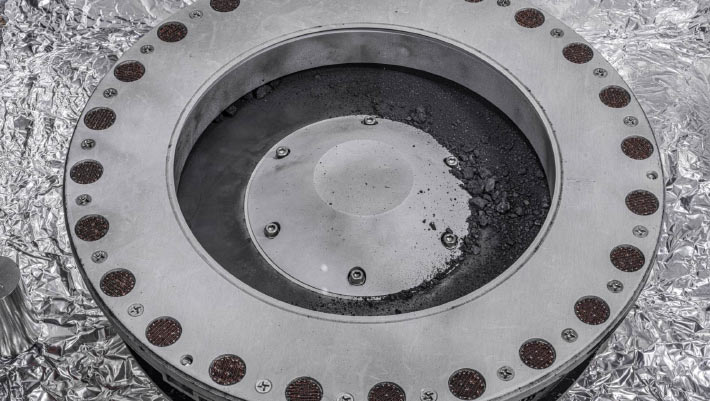The sample was collected by NASA’s OSIRIS-REx (Origins, Spectral Interpretation, Resource Identification and Security, Regolith Explorer) spacecraft on October 20, 2020 and arrived on Earth on September 24, 2023.
A view of the outside of the OSIRIS-REx sample collector. Sample material from asteroid Bennu can be seen on the middle right. Image credit: NASA / Erika Blumenfeld / Joseph Aebersold.
“The OSIRIS-REx sample is the biggest carbon-rich asteroid sample ever delivered to Earth and will help scientists investigate the origins of life on our own planet for generations to come,” said NASA Administrator Bill Nelson.
“Almost everything we do at NASA seeks to answer questions about who we are and where we come from.”
“NASA missions like OSIRIS-REx will improve our understanding of asteroids that could threaten Earth while giving us a glimpse into what lies beyond.”
“The sample has made it back to Earth, but there is still so much science to come — science like we’ve never seen before.”
“Although more work is needed to understand the nature of the carbon compounds found, the initial discovery bodes well for future analyses of the asteroid sample.”
“The secrets held within the rocks and dust from the asteroid will be studied for decades to come, offering insights into how our Solar System was formed, how the precursor materials to life may have been seeded on Earth, and what precautions need to be taken to avoid asteroid collisions with our home planet.”
“The goal of the OSIRIS-REx sample collection was 60 grams of material from the surface of the near-Earth asteroid (101955) Bennu.”
Curation experts at NASA’s Johnson Space Center, working in new clean rooms built especially for the mission, have spent 10 days so far carefully disassembling the sample return hardware to obtain a glimpse at the bulk sample within.
When the science canister lid was first opened, the researchers discovered bonus asteroid material covering the outside of the collector head, canister lid, and base.
There was so much extra material it slowed down the careful process of collecting and containing the primary sample.
“Our labs were ready for whatever Bennu had in store for us,” said Vanessa Wyche, director of NASA’s Johnson Space Center.
“We’ve had scientists and engineers working side-by-side for years to develop specialized gloveboxes and tools to keep the asteroid material pristine and to curate the samples so researchers now and decades from now can study this precious gift from the cosmos.”
Within the first two weeks, the scientists performed ‘quick-look’ analyses of that initial material, collecting images from a scanning electron microscope, infrared measurements, X-ray diffraction, and chemical element analysis.
X-ray computed tomography was also used to produce a 3D computer model of one of the particles, highlighting its diverse interior.
This early glimpse provided the evidence of abundant carbon and water in the sample.
“As we peer into the ancient secrets preserved within the dust and rocks of asteroid Bennu, we are unlocking a time capsule that offers us profound insights into the origins of our Solar System,” said OSIRIS-REx principal investigator Dr. Dante Lauretta, a researcher at the University of Arizona, Tucson.
“The bounty of carbon-rich material and the abundant presence of water-bearing clay minerals are just the tip of the cosmic iceberg.”
“These discoveries, made possible through years of dedicated collaboration and cutting-edge science, propel us on a journey to understand not only our celestial neighborhood but also the potential for life’s beginnings.”
“With each revelation from Bennu, we draw closer to unraveling the mysteries of our cosmic heritage.”




